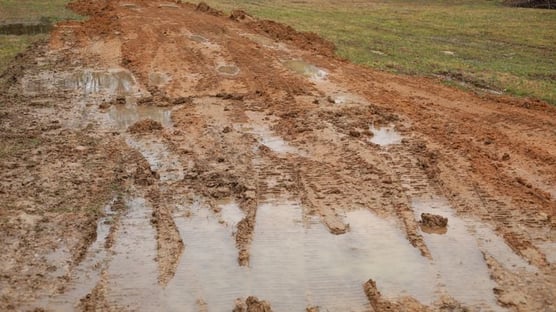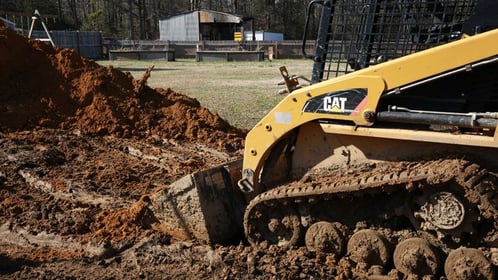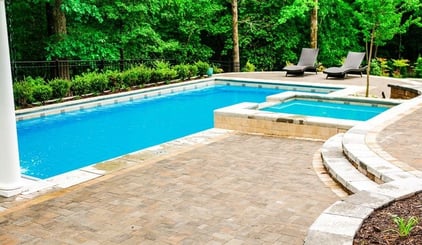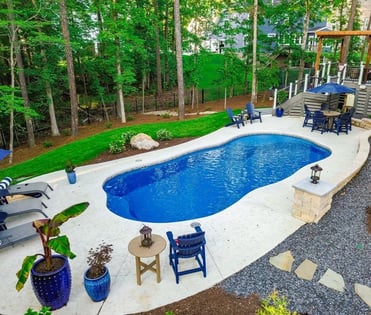
A fiberglass pool installation can be messy. Correction, a fiberglass pool installation WILL be messy. There's no way around it.
Inground pool installations, regardless of the type of pool you choose, require giant machinery to rip out a ton of earth and put in your beautiful new pool. It's not a clean, tidy process.
Looking through rose-colored glasses, it's easy to assume there won't be that many machines, and they won't make that much of a mess. We hear of comments all the time from homeowners saying, "I didn't know my yard was gonna be such a mess. No one told me."
Well, this is us telling you. It's going to be a mess.
Although we don't install pools, that's done by the independently owned and operated company you purchase your River Pools fiberglass pool from; we do have team members with LOTS of installation experience. On behalf of them and their years of experience, we're here to help align your expectations with pool installation reality.
How messy will your yard get during a fiberglass pool installation?
- Torn-up access lanes
- Piles of dirt
- Muddy tracks from equipment
- Cracks on the sides of an asphalt or concrete driveway
- Ruined grass
Psst: There's a reason installers recommend that for new-built houses, you should work with your builder to put in the pool before the landscaping and driveway. Get the messy work done first. Afterwards, you can craft the beautiful details and know that they'll stay in good shape.

What will mess up the yard during a pool installation?
All these things will collectively damage your yard:
- Dump trucks
- Concrete trucks
- Large trucks bringing flatbed trailers to haul the excavator
- The excavator and skid loader
- The truck hauling the crew back and forth
These machines will more than likely leave large, muddy ruts in your yard, sometimes two ruts if it's a tandem axle—that is, when there are two wheels side-by-side in the back.
Good news, though: those ruts can be filled in after the fact. You might even be able to use the piles of dirt to do it. Reduce, reuse, recycle.

You'll want to say your goodbyes to your grass before the installers arrive. Between the machinery and the piles of dirt, your grass is going to The Big Lawn In The Sky. You'll have to replenish that grass in areas outside the pool and patio.
Unfortunately, the damage isn't limited to the earth. The machinery might also damage your driveway. It could crack in the sides, especially if it's asphalt or concrete.
Heck, even a gravel or crushed stone driveway could be damaged! But, much like your lawn, it can be repaired. You'll just need to plan for that possibility.
Now, let's talk specifically about the excavator and the skid loader for a second.
The excavator's mess
The excavator, the most commonly used machine for digging your pool, has to get from one end of the pool to the other, and it needs to maneuver everywhere that the patio will be.
Translation: it'll leave trails everywhere.
The skid loader's mess
 Okay, so, the first question is what a skid loader even does.
Okay, so, the first question is what a skid loader even does.
The answer: It moves big loads around, like dirt and stone. It's the workhorse of the project site.
While it does the heavy lifting, the skid loader basically leaves you a road, but not in a nice way.
This is a muddy, dirty mess stretching from lots of different points in and around the property. It'll create these muddy paths and roadways throughout the project, in various places around your property.
While you can have conversations with your builder about minimizing impact for certain areas, don't expect much, if any, preservation. Instead, seek to understand where machines will need to maneuver, where dirt will need to be piled up (perhaps multiple piles), and where other materials will need to be staged.
What happens with all the dirt that comes out of the ground during a pool installation?

So, the pool installer excavates the hole where the pool will go. Cool. The excavated dirt has to be stockpiled nearby.
Listen. This ain't your average pile of dirt. This is a PILE of DIRT.
So whatcha gonna do with this mountain? There are basically two options you can choose:
- Keep the dirt so you can use it later
- Get the dirt hauled away
Maybe you need some dirt on your property at some point down the road. If you keep this pile, it'll be ready for you when the time comes.
Note: Some localities require dirt to be hauled away. Be aware of any rules about this in your area.
Either way, all that dirt has to be stockpiled somewhere near the pool hole. If it's going to stay on the property, it'll be moved again to another location.
Remember, wherever it sits, this pile of dirt will cover an area of grass at least the size of your pool or larger. Also remember, machines will be needed to relocate the dirt. Consider the space under the pile(s) and the path of the machines dead to you. You'll have to replenish it with new grass once all the major machine work is complete.
How long will the yard be messy from a fiberglass pool installation?
Just remember, none of this damage is permanent. On top of that, the exact duration of the chaos depends on the pool project. But to give you a sense for how long your pool may be under construction we asked the network of builders, who sell and install the pools we manufacture, about installation time ranges they are seeing in various markets around the country.
The consensus is:
Fiberglass pools can have the shortest installation time with 3-4+ weeks being reported.
Vinyl liner pools can take a little longer than fiberglass with 1-4+ months reported.
Concrete pool construction lasts for months. Yes, 3-6+ months being reported.
Be sure to ask the builders you're vetting about construction duration.
Is a fiberglass pool installation really worth the mess?
Well...take a look and decide for yourself.




Whether you love all-out aesthetics or prefer to keep life simple, the end goal of your pool project will be a thing of beauty.
We're firm believers in fiberglass pools. That's not because we deny the benefits of vinyl liner or concrete, but because we've seen how much joy fiberglass pools, in particular, bring families across the country.
The installation timeframe isn't the only potential perk, fiberglass pools have so many benefits:
- Easier maintenance
- Lower lifetime cost
- Non-abrasive surface
- Integrated steps and benches
- Manufactured in a controlled environment
- Beautiful aesthetics
Interested in seeing more styles? You can look at all the River Pools fiberglass pool designs, as well as the available tanning ledge and spa add-ons.
You can also check out the pool-type selector tool, which can help you decide if fiberglass is the best type of pool for you.
Up Next:
Pool Construction: Comparing Concrete, Vinyl Liner, and Fiberglass Installations
DIY Concrete Swimming Pool: Construction, Cost, Problems, and More
Editor's note: This article was originally written by Holly Jender and was updated on March 11, 2025 with current information. River Pools is a brand of inground fiberglass pools produced in a manufacturing facility in Fortville, IN. While our expertise is in manufacturing fiberglass pools, we have access to a network of installers with expertise relating to project design, installation, and pool service. We often tap into this knowledge base and share information freely with homeowners, just like you, considering installing a swimming pool in your backyard.


